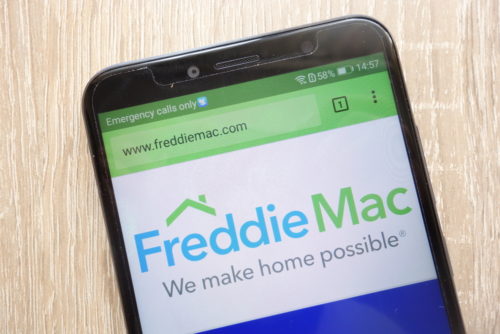Almost everyone refers to the Federal National Mortgage Association (FNMA) as “Fannie Mae,” while “Freddie Mac” is the nickname for the Federal Home Loan Mortgage Corporation (FHLMC). Both of these companies are publicly traded, government-sponsored enterprises (GSEs).
Fannie Mae started as part of FDR’s New Deal in 1938. It helped with the economic recovery after the Great Depression by creating a secondary mortgage market. At first, Fannie Mae bought Federal Housing Administration-insured loans, which had protection against default. Later, it started buying conventional mortgages as well. In 1970, Congress established another GSE, Freddie Mac, to compete with Fannie Mae, create a more-robust secondary mortgage market, and make it easier for homebuyers to get loans to purchase a house.
Neither of these companies provides home loans directly to consumers. Instead, they purchase mortgages from other lenders that meet their standards. The lenders get profits from the sale that they can use to offer additional mortgages to other property buyers.
Fannie and Freddie seek to create conditions that allow lenders to offer affordable mortgages with predictable monthly payments. After they buy them from lenders, the companies then securitize these mortgages, usually using bonds that package many mortgages together. They sell the bonds, which transfers the risk of default to investors.
Both enterprises also have programs for lower-income homebuyers. They purchase mortgages insured by the FHA and from other government agencies and nonprofits that provide home loans to low-income buyers or other home buyers with economic disadvantages.
Table of Contents
Fannie Mae vs. Freddie Mac
These two government-sponsored enterprises are similar in many ways, but they do have some crucial differences.
- Where do they purchase mortgages? Fannie Mae buys mortgages from large commercial and institutional banks, while Freddie Mac usually works with smaller banks, which those in the lending industry often call “thrift banks.”
- How did they start? Fannie Mae was the original company that created a secondary mortgage market in the US in 1938. Freddie Mac is much younger. It began operations in 1970 when Congress created it to provide competition for Fannie Mae and create a more robust secondary market.
- How do they make money? Both make money by selling mortgage-backed securities to investors. Despite being younger, Freddie Mac was the first to sell repackaged mortgage products to investors.
- What requirements do they have for the mortgages they buy? Fannie Mae and Freddie Mac both have different guidelines for the types of mortgages they purchase. These guidelines affect consumers because lenders create loans with terms that satisfy these guidelines so that they can resell the mortgages.
Fannie Mae Guidelines
Fannie Mae buys qualifying loans from lenders. To qualify, mortgages need to meet requirements for down payments and other factors, such as the debt-to-income (DTI) ratio of the applicant. There are also rules about how large your mortgage can be. Fannie Mae only purchases first-lien mortgages, not second mortgages, though they do have additional programs for refinancing and other home-related loans.
- 20% is the largest down payment you could need to make for a single-family home. However, Fannie Mae also has special programs such as Home Ready. For this program, a buyer needs to make at least a 3% down payment for fixed-rate mortgages, and 5% for variable-rate loans. However, most lenders require mortgage insurance if your down payment is less than 20%.
- Debt-to-income ratio requirements vary depending on the applicant’s down payment and credit score. If your credit score is between 620 and 680, you need a debt-to-income ratio of 36% or less. If your score is above 680, you can qualify with a 45% DTI ratio.
- Buyers cannot earn more than 80% of the median income to qualify for Fannie Mae’s Home Ready program, but they do need a credit score of 620 or more.
- For a single-family home, the maximum loan amount is $510,400. In some designated high-cost areas, such as in major cities with high real estate prices, the maximum is $765,600.
Freddie Mac Guidelines
Freddie Mac guidelines are similar to Fannie Mae’s, but some of them are slightly different. Keep in mind that Freddie Mac focuses most of its mortgage-buying efforts on thrift banks, not on large commercial banks.
- Freddie Mac requires a 5% down payment, but lenders also usually require mortgage insurance until the principal balance drops below 80% of the purchasing cost. Like Fannie Mae, Freddie Mac has special programs, such as Home Possible and HomeOne, which only require a 3% down payment.
- To qualify for Home Possible and other special programs, you need to be at 80% or below of the average median income for your area.
- Your debt-to-income ratio needs to be 36% or lower if you have an average credit score between 620 and 680. Your DTI ratio can be as much as 45% if your credit score is above 680, or 720 if you can only make the minimum down payment.
- For special programs such as Home Possible, the home needs to be your primary residence. However, you can also get Freddie Mac mortgages when refinancing or for investment properties or multi-unit properties.
Government-Sponsored Enterprise
Both Fannie Mae and Freddie Mac are government-sponsored enterprises (GSEs). They were created by Congress to provide financial services for Americans. In the case of Fannie Mae and Freddie Mac, the goal is to ensure the flow of credit to consumers.
By buying mortgages from lenders, they ensure that lenders have the capital to remain active and provide additional loans (instead of having their money tied up for 30 years by holding onto the mortgages).
Also, the government can use GSEs to dictate the terms of mortgages. Both Fannie Mae and Freddie Mac have specific guidelines for the mortgages they purchase. Since lenders want these two GSEs to buy their mortgages, they ensure that their loans meet the guidelines, which are often more favorable to consumers.
Secondary Mortgage Market
The secondary mortgage market involves the sale of securities and bonds that have mortgages as collateral. Fannie Mae and Freddie Mac both use mortgages they purchase to create financial products that they then sell to investors. The sales of these mortgage bonds and securities passes the risk from the GSEs to investors. In an ideal situation, this transaction is a win-win deal. Investors get the chance to make profits while Fannie Mae and Freddie Mac pass the risk from themselves (and the government and taxpayers) to investors.
Image Source: https://depositphotos.com/





